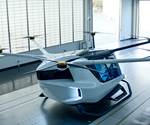Voith Composites, HRC to develop hydrogen pressure vessels for EVs
The next-generation filament-wound composite high pressure vessels will be designed for use with fuel cell electric vehicles.

Representatives of Voith Composites and HRC signed a letter of intent in Shanghai on Aug. 22. The companies will co-develop hydrogen high-pressure vessels for fuel cell applications. Pictured, left to right: Yihong Ge, chief financial officer of HRC Group; Yongtao Gu, president of HRC Group; Matthias Odrobina, CEO of Voith Composites; and Dr. Lars Herbeck, chief technical officer of Voith Composites.
Voith Composites (Heidenheim, Germany) and composites solutions provider HRC (Shanghai, China) have partnered to develop next-generation hydrogen high-pressure vessels for fuel cell electric vehicles (FCEV). Representatives from both companies signed a memorandum of understanding on Aug. 22.
According to the companies, new pressure vessel concepts, process sequences and materials systems need to be developed to meet current market requirements for fuel cell electric vehicles, and to enable FCEVs to compete with conventionally powered vehicles. The companies plan to combine Voith Composites’ expertise in manufacturing filament-wound composite pressure vessels with HRC’s expertise in the Chinese automotive market.
“One of the greatest challenges of future vehicle concepts will be high-pressure vessels, which will be installed in FCEV as hydrogen tanks and represent one of the biggest cost drivers. More cost-effective solutions will allow new, more competitive applications on the market for fuel cell electric vehicles. Reducing process costs in combination with new vessel concepts is of decisive importance, and this forms the basis of the partnership between HRC and Voith,” says Dr. Timo Huber, vice president of R&D at the HRC Group.
“China is currently the most important market for vehicles with pressure vessels. With HRC, we have a strong partner at our side with comprehensive expertise in the Chinese market,” says Matthias Odrobina, CEO of Voith Composites. “We have considerable experience in the industrial, automated manufacture of wound composite components such as pressure vessels. I am convinced that by signing this agreement, we will reach a new level of cooperation where both companies will benefit from the broad potential market.”
Voith Composites reports that by the end of 2018, the capacity of hydrogen fuel cells in use worldwide had exceeded 2,090.5 megawatts, and total sales of fuel cell passenger cars, in which the commercial application was implemented for the first time, amounted to 9,900 units.
Related Content
-
Materials & Processes: Fabrication methods
There are numerous methods for fabricating composite components. Selection of a method for a particular part, therefore, will depend on the materials, the part design and end-use or application. Here's a guide to selection.
-
Large-format 3D printing enables toolless, rapid production for AUVs
Dive Technologies started by 3D printing prototypes of its composite autonomous underwater vehicles, but AM became the solution for customizable, toolless production.
-
Plant tour: Albany Engineered Composites, Rochester, N.H., U.S.
Efficient, high-quality, well-controlled composites manufacturing at volume is the mantra for this 3D weaving specialist.

.jpg;width=70;height=70;mode=crop)













.jpg;maxWidth=300;quality=90)
